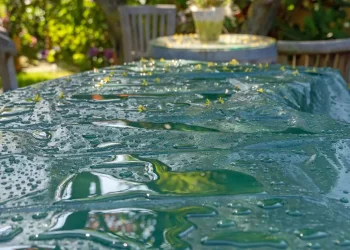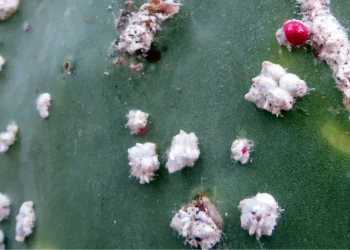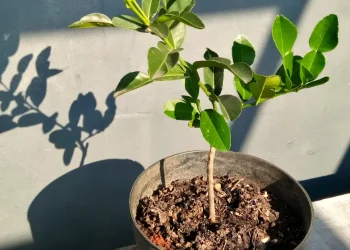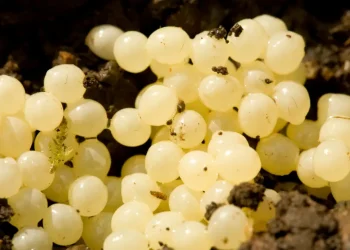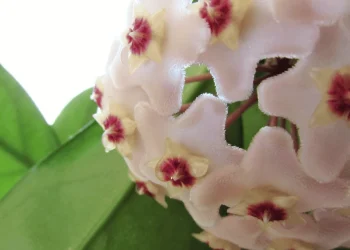You are caring for your Monstera as well as you can. But then something happens that you have never seen before: a brown crust forms on the stems of your Monstera.
It keeps bugging you because it looks very different than regular browning on your plants. Do you recognize yourself in this situation?
It won’t be puzzling you for much longer because today, you’ll find what the brown crust on the Monstera stem is and how to fix it. Well, spoiler alert: the fix may be much easier than you can imagine. Let’s dive in!
What’s the Brown Crust on Monstera Stems
The brown crust on Monstera stems is completely normal. It’s a woody material that the plant grows near the leaves to support its growth.
Especially on Monsteras, the leaves tend to grow very big and heavy. So it’s not a rarity to see Monstera’s stem breaking at a certain spot.
As your Monstera matures, it undergoes lignification, a process where certain cells thicken and strengthen, forming a sturdy layer on the stem’s surface. This brown, woody crust is the plant’s way of ensuring its structural integrity.
In the same part as this crust forms, you can also find another vital part of the plant known as the geniculum. The geniculum is essentially a flexible join found in plants, serving as a pivot point that allows them to adjust their leaves’ orientation towards sunlight.
In the left image, you can see just a beginning lignification. The plant is not yet fully matured, so it doesn’t need to hold that much weight. But once your Monstera gets really big, it can look something like in the second image.
What’s Browning on the Stems on Monstera
A different kind of brown Monstera stem is when old tissue is dying and being replaced by a new one. This one is also a natural and common occurrence but not very desirable.
It is completely normal when a new leaf pops out. It’s a sheath that initially protected the stem. But when whole stems are browning, it can signal some underlying issues.
This type of browning can be caused by too much sunlight, as the stems are getting scorched, overwatering, or rarely by pests or diseases.
1. Too Much Direct Sunlight
If the brown stems are dry and crispy to the touch, too much direct sunlight is probably the culprit.
While loving bright, indirect light, Monstera plants can suffer when subjected to prolonged periods of harsh sunlight. The intense rays can scorch the plant’s delicate tissues, including stems, causing them to turn brown.
Unfortunately, there’s no way to fix this as the parts of the plant are already dead. But you can prevent future damage by moving your Monstera to a better spot.
Monsteras are native to the tropical rainforests of Central and South America, where they thrive in the dappled sunlight that filters through the dense canopy. And you should try your best to recreate that. Try to find a place in your home where the plant will receive 8 to 10 hours of filtered sunlight a day.
2. Overwatering
Too much water can drown the plant’s roots. As all the little holes and cavities between the soil grains get filled up with water, oxygen can’t freely flow through. This imbalance can lead to root rot, and as a consequence, the stems will turn brown.
Although many gardeners still hate this “trick,” it’s a great tool if you are unsure when to water your plants. Simply use your finger as the guide and check if the top inch of the soil already dried out. If there’s still moisture, wait a few more days before watering again.
3. Diseases or Pests
Diseases or pests are not that uncommon in plants. I labeled it as “rare” because when your Monstera is infected, it will manifest in numerous other issues, such as yellowing of the leaves, bite holes on the surface of the leaves or stems, or complete dieback, but sole browning of the stems is not a common sign of infestation.
If you think your plant may be sick, swift action is very much needed. I wouldn’t be afraid to reach for fungicide or insecticide right away. Both fungi and insects can spread and reproduce very quickly, and before you know it, your whole garden can be infected.
Pests and diseases often, not always, come together with other already mentioned issues – especially overwatering. High moisture is very inviting for fungi and all kinds of bugs. So, you should also check on that and deal with the underlying issue to fully fix that.
Before you go…
As you can see, browning on Monstera can have many different causes, and depending on its characteristics, it can actually be beneficial for the plant. But whether or not it’s a good thing doesn’t change the fact that proper care is always important, not just when a problem arises. Recently, I published an article focused on growing Monstera with big leaves. It mentions all the essentials…



